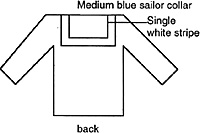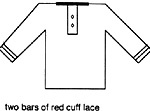I am really enjoying getting the Heliograph again. You are doing a fine job - I loved all the various tidbits, letters from people etc. Sorry for this handwritten missive - my computer has a virus.
I think that the new Foundry Belgians are fantastic and quite accurate. They don't look anything like Germans. The painting information provided by Foundry is quite good as well.
My various sources include an old Savage and Soldier article from the 1960s. This says that the askari wore baggy blue shirt and short trousers with red sash and fez. They wore no shoes or leggings. The officers wore white linen uniforms and helmets.
 The article also maintains that Belgian sailors were
in Africa and wore a similar uniform to the French
Navy. The uniform was all white except for a medium
blue collar with a single white stripe edging the collar.
The article also maintains that Belgian sailors were
in Africa and wore a similar uniform to the French
Navy. The uniform was all white except for a medium
blue collar with a single white stripe edging the collar.
The cap was dark blue with a blue pom-pom. They also wore straw hats similar to British and French sailors.
Apparently Maxims, Nordenfelts and Krupp guns of various sizes were asl used by the Belgians. The Askari were armed with the Albini rifle - a converted rifle- musket similar to the trapdoor Springfield or Snider rifle. Officers carried Mausers. Leather equipment was made from black leather. Rifle slings, however, seem to be of a redbrown leather.
 A December 1989 Miniature Wargames article
by a Belgian on the Belgian campaign against the
Malidists confirms the above details. Some of the Force
Publique askari were apparently from the Hausa tribe
(also a recruitment source for British askari) and wore
red trim around the collar, on the cuffs and down the
front panel containing the buttons. The shirt looks like a
long-sleeved tennis shirt with the collar cut off. Askari
from the Bangalas tribe apparently wore yellow trim.
The straw hat could also be turned up like an Australian
bush hat.
A December 1989 Miniature Wargames article
by a Belgian on the Belgian campaign against the
Malidists confirms the above details. Some of the Force
Publique askari were apparently from the Hausa tribe
(also a recruitment source for British askari) and wore
red trim around the collar, on the cuffs and down the
front panel containing the buttons. The shirt looks like a
long-sleeved tennis shirt with the collar cut off. Askari
from the Bangalas tribe apparently wore yellow trim.
The straw hat could also be turned up like an Australian
bush hat.
An April 1981 Military Modeling article on "the Zouave style" shows the blue askari uniform with red trim and red sash. This is a collarless over shirt with red trim around the cuffs, neck hole and button tab.
The same article also shows an interesting picture of a Sikh policeman in full dress for Central Africa, 1891. He wears a yellow fez with a black turban, white shirt, black zouave jacket with yellow cuffs, white sash, yellow zouave pants and white leggings. The jacket is trimmed with a yellow stripe with black central line. There is no fez tassel. The leather waist belt is black. The three colors of the uniform apparently represented the three races serving together in Central Africa.
Also
Back to The Heliograph #115 Table of Contents
Back to The Heliograph List of Issues
Back to Master Magazine List
© Copyright 1999 by Richard Brooks.
This article appears in MagWeb (Magazine Web) on the Internet World Wide Web.
Other military history articles and gaming articles are available at http://www.magweb.com